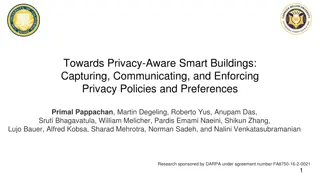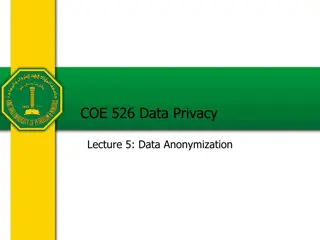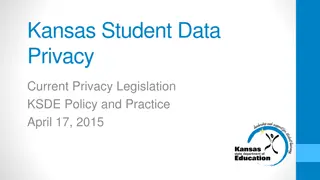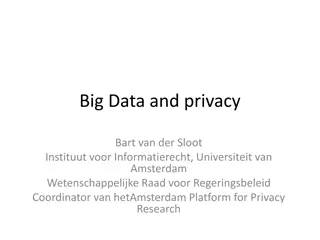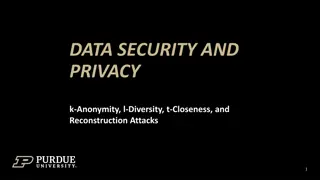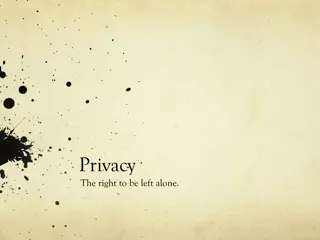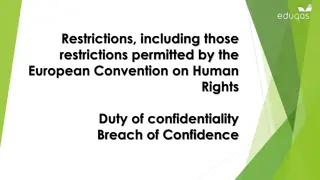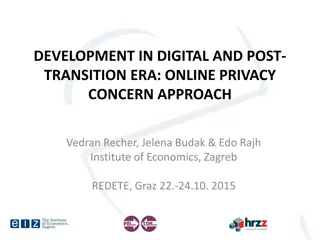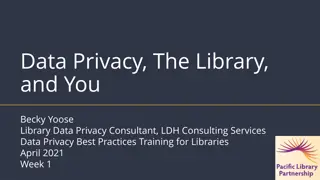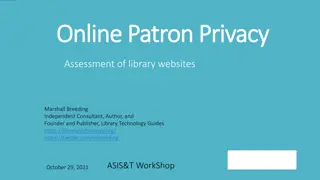Understanding Online Data Collection and Privacy Concerns Among Parents and Children
Children are growing up surrounded by technology, with high access to devices like tablets. They struggle to understand how their data is collected and used by online platforms, while parents are more aware but feel privacy settings need clarity. Concerns include online bullying, exposure to harmful content, excessive screen time, and sharing personal details with inappropriate individuals. Companies collecting information about children's online activities is a top concern among UK parents. The Insights Family provides valuable data on kids, parents, and family market research.
Download Presentation

Please find below an Image/Link to download the presentation.
The content on the website is provided AS IS for your information and personal use only. It may not be sold, licensed, or shared on other websites without obtaining consent from the author. Download presentation by click this link. If you encounter any issues during the download, it is possible that the publisher has removed the file from their server.
E N D
Presentation Transcript
The Insights Family: Parents and Children s Online Data Online Data, How It s Used & The Attitudes Surrounding It
Whats Popular Online? Apps Devices Networks & Websites Trust Data Collection, How It s Used & Parents & Children s Understanding General Understanding Data Collection & Uses Barriers & Problems Contents should be a default Attitudes, Key Concerns & Worries Around Data Collection & Online Use Attitudes Key Concerns & Worries Appendix References
Children are growing up more tech-savvy than previous generations, with high numbers of device access, for example, 72% of children aged 3-18 have access to a tablet. Younger children especially struggle to differentiate between how other users and corporations access and use their data. There are varying levels of understanding about how data is collected from social media. However, children believe there is an acceptable trade-off between data disclosure and the benefits of using the social platforms. Due to Covid-19, children have been spending more time gaming and on social media. Children claim these activities help with social connection. Studies have shown that children are confused about how data is collected, stored and who has access to it. Parents are more aware than children of the different ways data is collected online but believe that sites privacy settings need to be made clearer. Whilst older children are more aware of the purposes and outcomes of some forms of data collection i.e. profiling, younger children struggle to understand why their personal information is valuable. There is agreement between parents and children that terms and conditions are too lengthy and complicated, often confusing the children. There is an awareness among children about the risk that arises from sharing too much personal information i.e. addresses and telephone numbers. However, this is mainly linked to stranger danger and its consequences. There is less awareness of how inferred data is collected from sources, like browsing history. Executive Summary
1. Companies collecting information about what their child is doing online (57%) TOP 5 CONCERNS AMONG UK PARENTS ABOUT THEIR CHILD S ONLINE ACTIVITIES 2. Child being bullied online (54%) 3. Child seeing content that encourages them to hurt themselves (54%) 4. Amount of time child spends online (53%) 5. Child giving out their personal details to inappropriate people (50%) Data comes from 19. Children and Parents: Media Use and Attitudes Report 2020/21
Whats Popular Online? The Insights Family Findings The Insights Family is the global leader in kids, parents and family market research, providing the most comprehensive and dynamic market intelligence, through its Kids Insights and Parents Insights services.
Children are becoming increasingly more tech-savvy. Data shows they are frequently using apps and social media sites but with that comes concerns around privacy, hacking and trust.
248% TikTok s popularity has grown by 248% from 2019 to 2020 Data comes from Kids Insights UK research, January 1st 2020 December 31st 2020
Childrens Use of Apps Looking at 2020, data from Kids Insights children aged 3-18 spend an average of 1h:14m on apps per day, across smartphones, tablets and other connected devices. shows Smartphones and tablets are by far the most popular method for children across the UK to access their favourite apps. Teens and Tweens in the UK are predominantly using smartphones, with 2020 data indicating that 84% of children have access to a smartphone. Children aged 3-9 are mainly accessing their favourite entertainment through tablets such as, the iPad and Amazon Kindle, with 78% of children having access to one. Children s time and focus is mainly towards online videos, with YouTube being the favourite app for 12% of all children across the UK. The data also indicates that teens (10-12s) and tweens (13-18s) have been spending significantly more time on TikTok, (a video-sharing social media platform) than they were last year. TikTok s popularity has grown by 248% from 2019 to 2020 as trends have accelerated on the app (among 10- 18s). Social media is a strong presence on children s connected devices. Popular platforms such as Instagram, Snapchat and Facebook can be found on most tweens and teens devices. Children s time and focus online has shifted towards more private methods of communication. As children s social media use has diversified, messaging platforms like Snapchat and WhatsApp have surged in popularity among younger children. Disney+ s release in late March exploded in popularity across the globe, with a wide array of shows and films on offer to stream on-demand on the platform. The survey results indicate that amongst 3-9s in the UK, Disney+ is the 5th favourite app for 2020. Unless otherwise mentioned, data comes from Kids Insights UK research, based on January 1st 2020 December 31st 2020. 1. Access Denied
69% of UK children, aged 3 18 have access to a smartphone Data comes from Kids Insights UK research, January 1st 2020 December 31st 2020
Childrens Device Access and the Implications Kids Insights aged 3-18 have access to a tablet within their household and that 58% own their own tablet. This suggests an increased level of trust from parents in terms of children behaving responsibly with technology, compared to previous years. data shows that 72% of children On top of this, 2020 saw significant growth of gaming for children across the globe. In the UK, 2 in 3 tweens and teens (10-18-year-olds) have access to a gaming console, with the PlayStation 4 being the most popular. Children have spent an increased amount of time gaming during the lockdown periods and gaming has innovated the entertainment world with its unique levels of immersion. Similarly, 69% of all UK children, aged 3 18 have access to a smartphone of any kind, with 55% owning their own. This translates to around 6.9m children in the UK. Another external study, looking into a safer internet and the mental implications on children, found that 73% of 8-17 year olds state that being online helped them through the pandemic and lockdown. Parents also noted that their children spent significantly more time online in 2020 compared to 2019. A 2019 Ofcom study showed that around half of ten year olds now own their own smartphone. Between the ages of nine and ten, smartphone ownership doubles. This trend is growing as the world adapts and is becoming more connected than ever before. Further to this, the use of smart speakers among children aged 5-15 has doubled over the last year . Digital home assistants such as Amazon Echo and Google Home have become central to most households that use the internet heavily. Kids Insights data shows that 12% of 3-18s prefer to control their devices by using their voice (such as through smart speakers) - indicative of 1.55m. Also, 1 in 4 children use Smart Speakers for up to 1 hour every day. Laptops are also popular among children, perhaps due to their increased capabilities and power over that of the average smartphone or tablet. This data shows that across UK children aged 3-18, 62% have access to a laptop within their house. They are also frequently used to browse the internet and to access their favourite websites such as, Netflix and YouTube. Unless otherwise mentioned, data comes from Kids Insights 2. Children and Parents: Media Use and Attitudes Report 2019. 3. An Internet Young People Can Trust UK research, based on January 1st 2020 December 31st 2020.
1h:35m is how long teens are spending on social media every day Data comes from Kids Insights UK research, January 1st 2020 December 31st 2020
Childrens Networks & Website Use Kids Insights spend around 1h:35m every day using social media, demonstrating the huge popularity and influence social media has on children today. The data indicates that around 53% of tweens (10- 12s) use Instagram, this is a +6% increase from 2019. With this growing popularity, dangers can also grow. One external report presents that girls, particularly teenage girls, are more likely to share pictures and videos of themselves. Girls are also increasingly more likely to share their location with friends and family as they reach their teen years. Similarly, they re more likely to report communicating with strangers as they get older, whilst the opposite is seen for boys. data shows that teens (13-18s) According to the Children s Commissioner for England, gaming is an extension of play and an extension to their lives from the offline world. Gaming allows them to spend their free time developing relationships, learning new skills and having fun.4 This shows that gaming and other sites where children can connect, help them through difficult times and help as an outlet for them. As well as this, children s attention has become increasingly fragmented and keeping them entertained can be difficult. Kids Insights indicated that 17% of 3-9s are visiting YouTube (not incl. YouTube Kids) multiple times a day, trying to keep themselves entertained with the huge array on content on the platform. On top of this, Kids Insights most teens (13-18s) are concerned with their privacy (46%), hacking (45%) and cyber-bullying (43%) on social media platforms. These concerns have become more prominent since 2019, which may be in part due to concerns around mental health increasing (31% in 2020 vs. 4% in 2019). data shows that Additionally to this, messaging platforms such as WhatsApp, Snapchat and Facebook Messenger have become more relevant to children and have helped them to stay connected. However, around one in ten children are messaging people they don t know. The percentage of children does not increase with age suggesting that a worrying number of younger children (aged as young as 8, 9 and 10) have contact with strangers on messaging sites. Unless otherwise mentioned, data comes from Kids Insights UK research, based on January 1st 2020 December 1st 2020. 1. Access Denied. 4. Gaming The System.
Trust 25% of 8-17 year olds trustthe content they see online more what they see offline Kids Insight reveals that 32% of 13-18 year olds don t trust websites data 37% of 13-18 year olds don t trust social media All data comes from Kids Insights UK research, based on January 1st 2020 December 1st 2020, 3. An Internet Young People Can Trust
Data Collection, How It s Used & Parents and Children s Understanding
Children of varying ages understand that personal details are collected online i.e. from outlets like Social Media Sites. However, there is confusion around how exactly data is collected and stored and who has access to this. Concerns stem from areas like Terms and Conditions, inferred data and location tracking.
49% of parents are concerned about companies collecting data about their children 2. Children and Parents: Media Use and Attitudes Report 2019
Understanding Around Data Storage, Usage & Risk Numerous research studies have found that children are confused about how data is collected, stored, used, where it goes and who has access to this (seen across different age ranges) 1 5 6 7 10; with research suggesting children s lack of critical thinking skills as a potential reason for this. 11 6 Awareness of the risks of sharing telephone numbers and addresses is consistently seen across research. 8 9 Concealing personal information is mainly linked to the risk of stranger danger - strangers knowing children s location and personal information, and potentially being able to track them.5 8 Children struggle to understand why apps and sites request their personal data that seems irrelevant to the activities they are doing. 6 8 With age comes deeper understanding of motivations for data collection, with older children understanding that data collection can help make money, confirm identity when creating an account and enable market research. 8 Children also lack understanding as to why their data would be considered valuable. 3 6 There are mixed findings around the relationship between understanding and privacy concerns: one study found low understanding that sharing information online can lead to risks, 3 others found that children - especially older ones - are aware of the risks. 8 It s also been found that children can provide personal data passively and unconsciously on social media, due to a lack of understanding as to how data is collected.6 Different sources find that children, even the youngest ones, are aware that personal details are collected and used online. Children generally understand that personal data needs to be protected, and older age groups are aware that data can be tracked. 5 6 8 10 Lower income households are more aware of the risks of sharing personal data, and children from these backgrounds want to control their data. However, they have less access to technology and / or are more likely to be sharing their devices, which makes control harder.6 Children from low socioeconomic status (SES) homes also report having significantly fewer digital skills than their better-off peers. 11 Children, parents and carers understand the trade-offs between sharing data and using services. 6 8 However, evidence shows that around half of parents (49%) studied are concerned about companies collection of data about their children online. 2 Research also discovered that children from lower SES are much less likely to have a public social media profile or to share personal data, such as their address.6 1. Access denied. 2. Children and Parents: Media Use and Attitudes Report 2019 . 3. An Internet Young People Can Trust. 5. Who knows what about me? 6. Children's data and privacy online: Growing up in a Digital Age. 7. Children s online activities, risks and safety literature. 8. Towards a better digital future. 9. Children s online behaviour: issues of risk and trust. 10. Child Privacy in the Age of Web 2.0 and 3.0: Challenges and opportunities for policy. 11. Keeping Children Safe Online.
Data Expiration, Interconnected Devices & Trust One research paper found that there is some confusion around the lifespan of data, with research showing that children trust an organisation to recognise that they shouldn t keep it for too long and as such, think data use is temporary. Furthermore, because of the nature of peers changing and using different apps, devices and sites, children think data becomes irrelevant and there is a lack of understanding around this data remaining stored. 6 Research shows that there is a broad acceptance that trusted parties like doctors should be allowed to collect and use personal data like children s addresses, so that they could assist them in the case of an emergency. 5 8 Schools and GPs are often perceived to be more trustworthy than commercial organisations who are seen as using children s data in questionable ways.5 Children of all ages think people/organisations should only be able to access their personal data when it benefits them. 8 As a result, parents and children share data with public services without thinking about it.5 More research is needed into children s and parents awareness of the data collection around interconnected devices. Research has raised awareness of parents confusion around how interconnected toys record and collect data. 12 6 Many products are targeted at young children who lack digital literacy and there are numerous ways in which a child s data (or their family s data) gathered through these devices can provide risks. 5 5. Who knows what about me? 6. Children's data and privacy online: Growing up in a Digital Age. 8. Towards a better digital future. 12. Toys that Listen: A Study of Parents, Children and Internet-Connected Toys
4 in 10 children have public social media profiles 7 7. Children s online activities, risks and safety literature
Inferred Data Children are less aware of the indirect ways platforms are collecting data about them 6. As a result, children are sharing data (i.e. browsing data), thinking they are more protected than they are. 8 Children tend to think more about data they know they have given more than the data that s been inferred or taken. 5 Indirect data collection and use in terms of; profiling, metadata and cross-device identification is harder for children to grasp. 6 However, one study did find that children nowadays are growing up with more of an understanding of data being tracked and recorded, more so with age. 8 When the process of indirect data collection was explained to children, research found they feel extremely uncomfortable, stating that they don t like that they are not in control and feel like they haven t properly given consent. Children want platforms to be explicit about these data collection processes. 8 Tactics used by marketers to collect personal information from children cause concerns around data privacy, 10especially regarding children s ability to understand and consent. 5 These tactics have also been found to encourage young consumers to provide more personal information than is needed. 6 Younger children are less likely to understand that advertisements can target them based on concepts like history or search details (from a study looking at 3-17 year olds) 8. Whilst, older children are more aware of data traces i.e. advertisements and device tracking and are less concerned (among children aged 12-17) . 6 Parents on the other hand, are aware that it s more commonplace to share personal data and that it s collected in many different ways. 8 5. Who knows what about me? 6. Children's data and privacy online: Growing up in a Digital Age. 8. Towards a better digital future. 10. Child Privacy in the Age of Web 2.0 and 3.0: Challenges and opportunities for policy.
Social Media A further study found children aged 13-16 form zones of privacy for revealing personal information, in a way that allows them to remain close with friends but sustain privacy from strangers. 6 Regarding Social Networking Sites (SNS), across research, many children keep their social media profile public (42% have public profiles in one research study). 6 7 13 There s a difference in terms of age; younger children are more likely to keep their profiles private, whilst older children are more likely to remain public (the respondents are aged between 8 and 18).14 The very use of SNS requires the sharing of personal information and a study found that in order to not be considered a cyber hermit , users must make logical choices about how much personal information they post. 15 In one piece of research, over 1 in 3 of 8 10- year-olds admit that they said they are older than they are, in order to sign up to an online messaging service. 1 Children s online practices are shaped by their interpretation of the social situation and they choose to balance the need for privacy with the need for participation, self expression and belonging on a social platform. 6 Whilst there seems to be a lack of awareness of the privacy settings on SNS, there isn t a complete lack of understanding of what personal information can be collected from a public profile. One study showed how 12-17 year olds carefully consider what information they disclose and another found that older children are more aware of the risks associated with sharing on social. 6 Children seem to be more concerned with parents seeing their social networking sites than data being accessed by abstract authorities i.e. corporations. 6 15 1. Access denied. 6. Children's data and privacy online: Growing up in a Digital Age. 7. Children s online activities, risks and safety literature. 13. Risks And Safety On The Internet. 14. Children s Media Lives Wave 6. 15. UK young adults' safety awareness online is it a girl thing ?
Location Tracking There are mixed opinions on companies knowing children s location.6 However, this appears to be due to a lack of understanding on how companies use this data. Pre-teen years especially struggle with this concept as they can t differentiate between strangers and companies. They did agree however, that parents, teachers and doctors should know their location and saw this as a positive thing. 8 Offline safety is considered at risk when the use of tracking, monitoring or live broadcasting can reveal a child s personal information i.e. image or location. This isn t always understood by children. 6 Children of all ages dislike their location being shared with people they do not know and trust. 8 However, one study found that the act of being located by tracking a phone or device due to misuses of information is reported by less than a tenth of children across countries. 18 On the other hand, teens have a greater understanding of how location information was collected but are less concerned about big corporations like Facebook and YouTube using this form of location tracking. 8 Children are less aware of the indirect ways their location could be tracked, showing a need for a greater education on this topic. Similarly, few know what IP addresses are, or how they can be used to track location. And once the full range of location- tracking methods are explained to them, many report feeling uneasy. 8 Parents also have mixed views of geolocation tracking, with some claiming it is a double-edged sword in being able to keep their children safe but not knowing who will have hold of this information.8 Parents however, are generally unaware of live location features in apps such as Snapchat when informed, they tend to disagree with this function. 5 5. Who knows what about me? 6. Children's data and privacy online: Growing up in a Digital Age. 8. Towards a better digital future. 18. EU Kids Online 2020.
Profiling Research finds that there is some understanding among children around data being collected and used for profiling (more so in older children), but the idea around the specifics of profiling including how it works - are harder to grasp. For example, whilst many children have heard of cookies, few know how they can be used to build up a profile of them. 8 Profiling is better understood and accepted by parents. One study found that between 49% and 61% said Tailoring adverts to their age should be a default on sites and between 45% and 62% said Using usage history to personalise and recommend content should be allowed. 8 One research paper found that young people are less concerned about risks related to data mining and profiling by employers and authorities because dealing with them seems distant and not relevant to their life currently.6 Most children especially those older age ranges experience profiling, including videos that are recommended to them on YouTube and search engine suggestions (among research looking at 3- 17 year olds). 8 Research found that children understand the idea of algorithms and trust them (more than humans) to make more accurate decisions.8 On the other hand, children seem unsure how to avoid data profiling if they wanted. 6 There is further concern around the impact of profiling on children growing up nowadays, as there is more and more data available about them.5 5. Who knows what about me? 6. Children's data and privacy online: Growing up in a Digital Age. 8. Towards a better digital future.
3 in 10 parents believe that their children wouldn t understand Terms & Conditions 8 8. Towards a better digital future
Barriers to Understanding Terms & Conditions (T&Cs) Interpersonal / Commercial Conflict Research has repeatedly found that T&Cs and privacy notices are confusing to children, due to length and complicated legal language used. 1 5 6 8. Although staying safe online is a priority for many children, this is largely limited to protecting themselves from strangers, online predators, cyberbullying and harmful content shared by others. 5 One research paper stated that some older children think the language used is deliberately complex so that children won t understand. They also suggest that companies can include things in the writing that children don t agree with (among 3-17 year olds).8 Children see data privacy in a specific way, they tend to understand the significance of information they share directly with others more than with commercial organisations and public services. 5 There is a clear tension between children wanting to know more about data collection and choosing not to read the terms & conditions. 8 There s a clear gap in the understanding of the sharing and collection of data from commercial beings. 8 When asked, parents think that their children do not read terms and conditions because they re not interested (53%), there s no point because they have to accept to join (49%) and they wouldn t understand them (34%). 8 Children have access to how their friends/peers are interacting with their social accounts but they do not with commercial entities. It therefore seems to make them less concerned.6 One study revealed that 86% of parents and carers think that social media sites should show children the default privacy settings before signing up, 8 as children aren t always able to tell which information is mandatory or optional. 6 1. Access denied. 5. Who knows what about me? 6. Children's data and privacy online: Growing up in a Digital Age. 8. Towards a better digital future.
Reporting Problems In the past year, around one in ten children who use the internet among 8-11 year olds say that they have encountered something online that they found worrying or nasty in some way (with almost twice as many saying this among 12-15 year olds). Many children said they would report this, most likely to a family member. 7 Parents have been found to believe that older children should be able to directly complain to the site, whilst they are more likely to report a problem on behalf of a younger child. 8 Research found that children of all ages want complaints to be taken seriously but are not sure who to turn to. 8 Some younger children (from a sample of 3-17 year olds) assume platforms popular with younger children i.e., YouTube are regulated and are protecting their data rights.8 Around three-quarters of 12-15s are aware of online reporting, with one in eight reporting something in this manner. 16 Older children (12 15 year olds) are more likely than younger children to tell someone in authority about negative content. 2 Research found that children don t think reporting problems to a platform or organisation was likely to be effective. 8 2. Children and Parents: Media Use and Attitudes Report 2019. 7. Children s online activities, risks and safety literature. 8. Towards a better digital future. 16. Children and Parents: Media Use and Attitudes Report 2017
Attitudes, Key Concerns & Worries Around Data Collection & Online Use
Children are concerned with concepts like data misuse or hacking which could allow them to be identified or located. There are lower levels of understanding around less-tangible data and its consequences i.e. browsing data or digital footprints.
1 in 10 children never feel safe online 18 18. EU Kids Online 2020
Attitudes Towards Data Collection and Usage A multi-country study recently found that 1 in 10 children never feel safe online.18 Regarding the types of data they feel comfortable sharing and therefore being collected, many children speak of the risk of sharing data that identified them or located them in terms of being stalked, kidnapped, cyberbullied etc. However, few talk about the concern of sharing less tangible data i.e. browsing history; perhaps as evidence from other research shows, because of the lack of understanding around this topic. 8 One piece of research found that children are most likely to have encountered upsetting content on video-sharing platforms like YouTube, followed by other websites, including SNS. 1 7 Children also often see content that is inappropriate for their age. 1 In terms of how the data is collected and used by social media and apps, childrens top concern was too many advertisements , especially among 8-11 year olds. Few, by contrast, worry about their digital footprint being collected and consequences of this in later life. 7 Evidence has found that children do not always feel in control of their data that platforms have and how third parties may access these without their permission. Sharing data with third parties is also generally seen as a negative by parents and carers,8 with parents lacking the understanding of how third parties gather and use personal data. 6 Children see online space as more private than offline equivalents, in part because parents are less present. 6 In terms of privacy settings, many children feel that more should be done by organisations to make their privacy settings clear. Older children (among a sample of 3-17 year olds), especially feel badly informed about these settings and worry they are sharing more data than meaning to and to unknown parties. 8 The evidence also suggests that children feel limited in their ability to change their online behaviour and they feel they don t have the time to continuously check privacy settings. 6 Children of all ages believe they should have the right to erase or restrict their online data. 8 1. Access denied. 6. Children's data and privacy online: Growing up in a Digital Age. 7. Children s online activities, risks and safety literature. 8. Towards a better digital future. 18. EU Kids Online 2020
Key Concerns & Worries
1 in 10 of 11-16 year olds have had their password misused, to access their personal information 5 5. Who knows what about me?
Misuse of Data In research exploring children s perceptions of mobile media , risk related to personal data was among top concerns. It has been found that 1 in 10 children aged 11-16 in the UK, experience personal data misuse; 1 in 10 have had their password used to access their information, with a further 4% saying their personal information has been used in a way they don t like. 5 Research found that between 8% and 36% of the children studied, report that their parents or carers publish information online without asking them first if it was okay for them to do so.18 This leads to a concern that parents are more in control of their child s personal information sharing than the children would prefer.6 One multi-country study found that experiences with data misuse are reported by fewer than 15% of the children in most of the countries reviewed. 18 Children (3-17 year olds) are more worried about the risks and consequences of an individual misusing their data than this being done automatically online. Most children studied, find it harder to understand the negative consequences of automated decision making. 8 This same study found that the experience of misuse of personal data increases with age (i.e. 2% to 14% of 9-to-11 year olds report this, compared to 6% to 33% of 15-16 year olds). Another concern around the misuse of data is from Sharenting ; social media updates by parents, which may reveal more information about children than intended, which can aid identify theft. According to Barclays, by 2030 sharenting will account for two-thirds of identity fraud. 5 10 Although, as sharenting is domestic processing, this does fall outside of GDPR. 5. Who knows what about me? 6. Children's data and privacy online: Growing up in a Digital Age. 8. Towards a better digital future. 10. Child Privacy in the Age of Web 2.0 and 3.0: Challenges and opportunities for policy. 18. EU Kids Online 2020
Scams, Hacking & Cyber-bullying. Research into online gaming has found that scammers are prevalent. 3 4 One form of scammer is an antisocial gamer who tricks others into revealing their personal information, with numerous examples of this occurring in different games. For example, in Roblox, children report being offered access to a generator to improve their game, in return for their private information or passwords. In this research in particular, children claim to be aware of these risks. 4 One research paper reported on a study of over 11,000 children aged 14-15 in the UK, whereby one in ten experience cyberbullying by phone or mobile. 7 Whilst a multi-country study found that, in almost all the countries, less than 10% of the children are bullied online. 18 A further study looked at research conducted by the UK Safer Internet Centre on 8 17 year old children, which found that 2 in 10 say someone has posted an image to bully them. One in three report a partner sharing their personal images widely without their consent, with this much more frequently reported in girls. 32% of the sample report that their partner has subsequently shared images more widely without their consent, with this again being much more frequent in girls (41% compared with 13% of boys respectively). 7 Beyond gaming, online scams are a worry, with one study finding 21% of children believing something that turned out to be a scam. 17 Another in-game concern was the idea of being hacked on gaming sites. 8 to 11 years olds worry about their personal data and identity being stolen. However, there is a lack of clarity around the consequences of this. 9 These findings are echoed in another report, where almost 2 in 10 children who admit to sharing nude images, are pressured or blackmailed into it, with around 17% saying their photos are shared further without their consent. Of those respondents sharing nude images, less than one third say they follow the online safety advice they were taught, which is a cause for concern. 17 Beyond gaming, the Cybersurvey by Internet Matters revealed a further risk of hacking online, with around 2 in 10 children surveyed revealing they have had their social media account hacked and they have believed something that turned out to be a scam. 17 3. An Internet Young People Can Trust. 4. Gaming The System 7. Children s online activities, risks and safety literature. 9. Children s Online Behaviours: Issues of Risks and Trust. 17. In Their Own Words, The Digital Lives of Children. 18. EU Kids Online 2020
Conclusion: Further research is needed around: We have found a wealth of research that reveals the varying levels of understanding around the different ways data is collected and used across ages. The effects of how periods of transition in a child s life (i.e. moving from primary to secondary school) can affect their attitudes to their data being collected and used. It appears that with age comes a greater understanding of the purposes of data collection, however there remain clear gaps in awareness around topics such as, how indirect data is collected and who to turn to, to report problems online. There is currently a lot of research regarding the harm of bullying but more evidence is needed on data driven harm. Across different ages, there needs to be a closer look at children s understanding of how commercial organisations are using their data in order to understand what needs to be taught. In terms of concerns, research has identified worries around data misuse, scams and cyberbullying. However, more evidence is needed around the harm associated with these. There are few research papers which examine the different types of misleading information and the risks of each of those, to children. There appears to be a gap in the understanding of how a child's digital footprint can affect them in later life. A deeper dive into how different SEG backgrounds feel about data collection and what influences this. Children appear to weigh up the consequences of data disclosure and/or unexpected use, with the benefits of being able to use a site or platform. In many cases, because they have often opted not to read the T&Cs, they don t understand how the data will be used and choose instead, to focus on the positives of using the site. Conclusion & Further Research
1. 2. 3. 4. 5. 6. 7. 8. 9. 10. Child Privacy in the Age of Web 2.0 and 3.0: Challenges and opportunities for policy, UNICEF, 2017 11. Keeping Children Safe Online, Green, Wilkins, Wyld, 2019 12. Toys that Listen: A Study of Parents, Children and Internet-Connected Toys. McReynolds, Hubbard, Lau et al, 2017 13. Risks and safety on the internet: the perspective of European children, Livingstone, Haddon, G rzig, lafsson, 2011 14. Children s Media Lives - Wave 6, Revealing Reality for Ofcom, 2020 15. UK young adults' safety awareness online is it a girl thing ? Pederson, 2013 16. Children and Parents: Media Use and Attitudes Report, Ofcom, 2017 17. In Their Own Words:The Digital Lives of Schoolchildren, Katz & El Asam, 2019 18. EU Kids Online 2020: Survey results from 19 countries, Smahel, Machackova, Mascheroni, Dedkova, Staksrud, lafsson, Livingstone, Hasebrink, 2020 19. Children and Parents: Media Use and Attitudes Report, Ofcom, 2020/21 Access Denied, Children s Commissioner, December 2020 Children and Parents: Media Use and Attitudes Report, Ofcom, 2019 An Internet Young People Can Trust, UK Safer Internet Centre, 2021 Gaming the System, Children s Commissioner for England, 2019 Who Knows What About Me? Children s Commissioner for England, 2018 Children s data and privacy online: Growing up in a digital age, Livingstone, Stoilova, Nandagiri, 2018 Children s online activities, risks and safety literature, Livingstone, Davidson, Bryce, 2017 Towards a better digital future, Revealing Reality, Information Commissioner s Office, 2019 Children s online behaviour: issues of risk and trust, Ofcom, 2014 References










